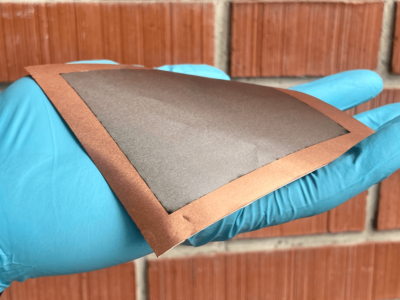
Theoretical polymer in prototype supercapacitors challenges lithium batteries
The polymer electrolyte provides practical capacitance values of up to 4F/cm2 on smooth low-cost metal foil electrodes. Existing supercapacitors on the market typically reach 0.3F/cm2 depending upon complex extended surface electrodes, athough there are many projects looking to boost this value, often through new electrode materials rather than the electrolyte.
Significantly the researchers, working with a company called Superdielectrics in Cambridge, managed to boost this further to 20F/cm2 with specially treated stainless-steel electrodes, and the details are part of a potential patent application. This could see supercapacitors with energy densities of up to 180Whr/kg, greater than lithium ion batteries.
Two protoypes have been developed The first uses small single layer cells charged to 1.5V for two to five minutes and then run demonstration devices, including a small fan. A three-cell series stack was then created that is able to be rapidly charged to 5V and operate an LED.
The reseeach at Bristol is going further by producing a complex series-parallel cell structure in which both the total capacitance and operating voltage can be separately controlled.
Superdielectrics was previously called Augmented Optics to develop new, electrically active materials for a number of electric and bio-electric applications. SuperCapacitor Materials Ltd was established in 2016 as a subsidiary to commercialise the development of crosslinked, gel-matrix polymers in supercapacitors from the research carried out by Superdielectrics, Surrey and Bristol. Superdielectrics is now looking to build a research and low volume production centre where the material could not only be used as a battery for future mobile devices and also in refuelling stations for electric cars.
“These results are extremely exciting,” said Dr Brendan Howlin, Senior Lecturer in Computational Chemistry at the University of Surrey. “We could be at the start of a new chapter in the technology of low cost electrical energy storage that could shape the future of industry and society for many years to come.”
“These exciting results are of particular satisfaction to me because they build upon my work in hydrophilic polymers that has been a major part of my professional life; beginning in the later 1970s with extended wear soft contact lenses, and leading in the period 1990 to 2009, to fuel cells and electrolysers of exceptional efficiency,” said Dr Donald Highgate, Director of Research for Superdielectrics. “The present work, if it can be translated into production, promises to make rapid charging possible for electric vehicles, as well as offering a much-needed low cost method of storing the transient output from renewable energy systems.”
www.supercapacitormaterials.com
Related stories:
- POWER TRENDS: FAB PLANS FOR ULTRACAPACITOR MATERIAL STARTUP
- EUROPE’S LARGEST SUPERCAPACITOR FACTORY OPENS
- LOSSES GROW AT SUPERCAPACITOR MAKER MAXWELL
- FLEXIBLE ORGANIC ULTRACAPACITOR TARGETS PACEMAKERS AND MEDICAL IMPLANTS
 If you enjoyed this article, you will like the following ones: don't miss them by subscribing to :
eeNews on Google News
If you enjoyed this article, you will like the following ones: don't miss them by subscribing to :
eeNews on Google News




